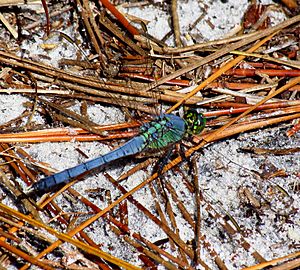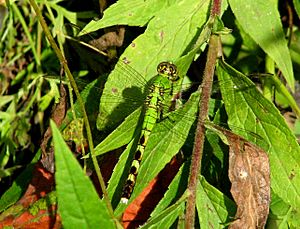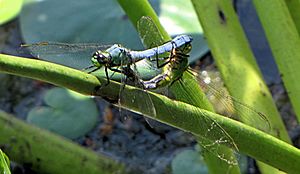Eastern pondhawk facts for kids
Quick facts for kids Eastern pondhawk |
|
|---|---|
 |
|
| Male | |
 |
|
| Female | |
| Conservation status | |
| Scientific classification | |
| Kingdom: | |
| Phylum: | |
| Class: | |
| Order: | |
| Family: |
Libellulidae
|
| Genus: |
Erythemis
|
| Species: |
E. simplicicollis
|
| Binomial name | |
| Erythemis simplicicollis (Say, 1839)
|
|
The eastern pondhawk (scientific name: Erythemis simplicicollis) is a type of dragonfly. It is also known as the common pondhawk. You can find it in the eastern two-thirds of the United States and in southern Ontario and Quebec, Canada. This dragonfly loves to live near ponds and calm waters. What makes it special is how different the males and females look. Females are bright green with stripes on their bodies. Mature males have a blue body, a green face, and a mix of green and blue on their chest area.
What Does It Look Like?
Baby eastern pondhawks, called nymphs, have green eyes. When they grow up and leave the water, they shed their skin for the last time. This is called moulting. The new adult dragonfly is a dull olive green at first. But in just a few hours, its body turns bright green with dark brown stripes. Their heads also get a shiny metallic green color.
As male dragonflies get older, their green color slowly changes. It becomes a duller blue, and then a powdery bluish-grey. Their wings have special patterns of lines. They also have dark edges near the tips. These dragonflies are about 36 to 48 millimeters (1.4 to 1.9 inches) long.
Where Do They Live?
The eastern pondhawk lives in parts of North and Central America. You can find them in Ontario and Quebec in Canada. They also live in much of the eastern United States. Their home range includes the Bahamas, the West Indies, Mexico, and Central America. They go as far south as Costa Rica.
This dragonfly is very common and found in many places. Because of this, a group called the International Union for the Conservation of Nature says it is a "least concern" species. This means they are not worried about it disappearing.
How Do They Live?

The eastern pondhawk is a strong and fast-flying hunter. It can catch other insects, like damselflies, while flying. When it's not hunting, it rests on plants. It stays ready to fly off if it sees prey nearby. When they first become adults, these dragonflies hunt away from the water.
After about two weeks, they return to the ponds. Male dragonflies then claim their own areas. They chase away other males. The males protect floating mats of algae. These mats are good places for females to lay eggs. Some other males, called satellite males, stay close by. They wait for a chance to find a female or take over a territory.
Mating happens when the dragonflies are sitting on plants near the water. About one minute after mating, the female starts laying her eggs. The male stays close by, flying above her to protect her. She flies low over the pond. She dips her body into the water to drop her eggs a little at a time. Some females mate many times in one day. In Florida, new adult dragonflies appear all summer long. An adult dragonfly lives for about ten days.


